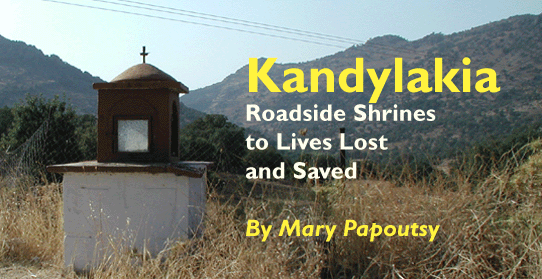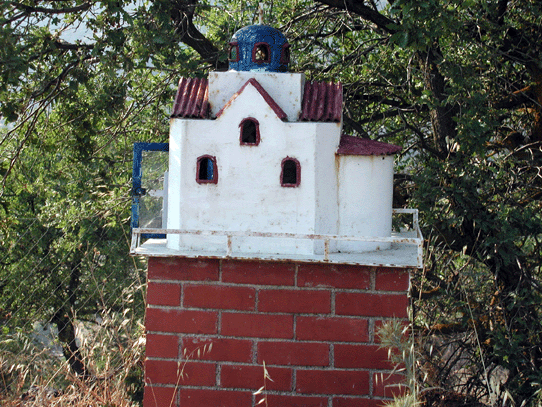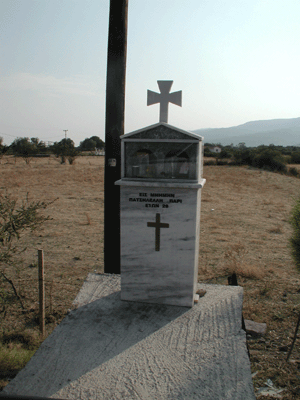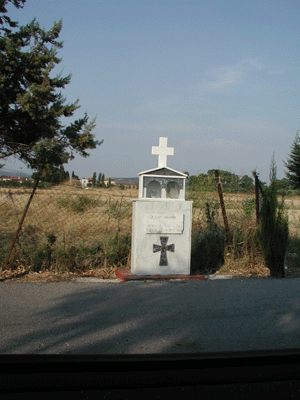 |
|
Article and Photos by Mary Papoutsy, Co-Founder and Publisher, Hellenic Communication Service
But these kandylakia do not always represent lives lost. They also mark lives spared. One man in Lesvos, Mihalis Kalontzis, recounted a harrowing tale. Many years ago, as a young man, he was returning by car to his village, Vatoussa, with several boyhood friends. Although the weather had not been ideal, the young men had traveled over this road many times before and so were not overly concerned about the driving conditions. As they neared the village, approaching one of the last sharp curves near a tiny, whitewashed church, an
Terribly shaken, but alive, Mihalis vowed to dedicate a kandylaki to his own patron saint, Archangel Michael, to the patron saint of the roadside church, and to the patron saints of the ecclesiastical feast day being celebrated on that day. Mihalis was good to his word. After he had recovered from the near-fatal accident, he constructed a kandylaki himself. A woodworker and cabinetmaker by trade, he set about fashioning his own kandylaki and obtaining three small icons to place behind the glass door. On anniversaries of this accident, he and his family bring small containers with Holy Oil to the kandylaki and briefly light small votive candles inside as thanks for the wondrous sparing of Mihalis' life on that eventful day many years ago. But not all stories have such happy endings. Some families tell of terrible losses at places
Although kandylakia often appear alike, some are quite unique and differ markedly from the customary simple lines to represent houses, Byzantine churches, and even grave stele. Materials also vary, depending on the choice of the family commissioning this shrine: metal, wood, marble, and even ceramic materials can be found. Each must be commissioned individually from local trades people--woodworkers, metalworkers, and stonecutters--but the family and tradesperson determine the overall shape and complexity jointly. Custom dictates that at least one icon and a votive candle be placed within the box, but some families include small bottles of Holy Oil and request that the date and name of the individual lost or saved be inscribed on the kandylaki. For the Greeks, then, these roadside shrines represent momentous occasions, some of them tragic, but others quite miraculous. Strong ties to family and cultural heritage guide the tradition of erecting dedicatory kandylakia. Lasting memorials to lost relatives are an essential part of Greek culture, drawing upon ecclesiastical tradition of annual memorial prayers, invocations of patron saints, and the lighting of candles. The kandylaki is reminiscent of a tiny church in some of its functions, serving as a repository for icons, Holy Oil, and candles. Family members recite prayers there periodically and tend the shrine as lovingly as they would a gravesite. For the kandylaki represents the world of the Greeks in miniature: their religious outlook, their attitudes toward relatives and ancestors, their understanding of the unpredictability of Fate, and their knowledge of the danger and occasional inhospitality of their surroundings. For the Greeks, remembrance is a cornerstone of society, remembrance of family, history, religion and culture. But above all, the kandylaki reminds every Greek traveler of the need to appreciate life, for just as it marks a life lost, so, too, does it mark a life saved.  (Posted August 2005) Click here to view a picture album of kandylakia in northern Lesvos, one of the largest Greek islands in the Aegean. |

|
2000 © Hellenic Communication Service, L.L.C. All Rights Reserved. http://www.HellenicComServe.com |

